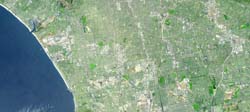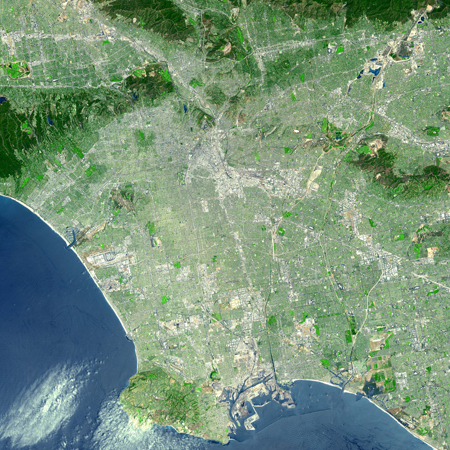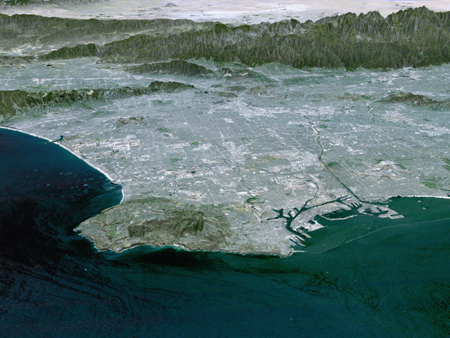Los Angeles

LA and its metropolitan area has grown to be an ethnically diverse, semi-tropical megalopolis, laying claim to being the principal center of the western US. It is one of the world's, and America's, second largest urban area with a population of 18 million people.
Los Angeles, "city of the thousand suburbs", has no city centre like many European cities. Indeed it has a multi-storey building development within the CBD (Central Business District), but the suburban ring extends as far as 50 miles (80 km) from the district along the west coast.
The city's economy is based on international trade, aerospace, agriculture, tourism, and film making. Los Angeles provides a glimpse of the typically cosmopolitan and global city of the future (NASA).

Source: NASA
In Los Angeles the local public transportation barely matters. An expansion of the underground railroad is not economical, due to great costs of earthquake security and low population density; only bus traffic is cost-effective. Therefore, the inhabitants of the city are almost entirely dependent on their cars. With an average of 72 hours congestion per person per year, Los Angeles unfortunately heads the congestion statistics of the USA (Claaßen 2008).
The "horizon city" mostly covers the coastal plains and lies within the inland valleys. The intervening and adjacent mountains are generally too rugged for much urban development. This is in large part because the mountains are "young", meaning they are still building (and eroding) in this seismically active (earthquake prone) region (NASA).
Urban realms
Urban realms are giant conurbations with multiple centres that function separately in certain ways but are linked together in a greater metropolitan sphere, a separate and distinct economic, social, and political entity within a larger urban framework. Los Angeles is a prototype version of such urban realms with a polynuclei city landscape.
The city mostly consists of single-storey scattered housing construction, traversed by a grid of streets and freeways. Regional shopping centres, business and industrial parks in the suburban zone are becoming the CBDs of the outer nuclei.
The growth of the outer cities has been the hallmark of American urbanization since the 1960s. In the 1970s and 1980s super highways, ring roads and other arteries were constructed. After ca. 1970, new suburban downtowns -so-called edge cities emerged to serve their new local economies, as multipurpose activity nodes. In the 1980s the settlement growth was about 26%, but, although it has decreased today, the city is still expanding along the highways.
The urban realm model constitutes the latest step forward in the interpretation of urban structure (Claaßen 2008, De Blij, Murphy 2003).
Los Angeles in different perspectives

Source: NASA Visible Earth
"Many people see in Los Angeles, a city that is dependent on the car and laid out for comfort and quality of life, in which more than half of the city area accounts for streets and parking spaces, many important political-cultural and social ideals lived out." (Schneider-Sliwa, cited in Claaßen 2008)
Tasks: 1. Describe with the aid of the various images, the topographic position of the city and its natural barriers.
2. Identify the consequences of severe suburbanisation in the area of Los Angeles.
3. Compare the suburbanisation in Los Angeles with the suburbanisation of the other cities displayed in the module (Mexico City, London, Johannesburg or Mumbai).
4. Try to explain the above quotation and evaluate it in respect to the urbanisation in the US.
